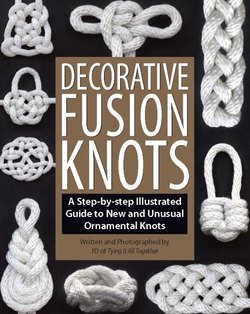Читать книгу Decorative Fusion Knots - J. D. Lenzen - Страница 7
На сайте Литреса книга снята с продажи.
ОглавлениеIntroduction
For tens of thousands of years, knots played a critical role in human society. They have helped us catch food, sail the seas, build empires, worship, remember and heal. Quietly supporting us through all our historic conquests and adventures, knots helped our ancestors tie their world together.
The Incas of South America, for instance, may have used knots tied along strings as an early form of writing—communicating narratives of the Incan Empire through knots rather than ink and paper. They also used knots as accounting tools, generating and keeping records similar to those kept by modern day bookkeepers and census takers.
More popularly, the Celts used stylized representations of knots to express a variety of natural and spiritual concepts. Seen on ancient structures and in modern motifs, these decorative knots conveyed the relationships between man and woman, hunter and prey, earth, spirit and the universe. Still other Celtic knots are believed to have represented protection from evil spirits, and were placed on battle shields or near people who were sick.
Asian cultures, primarily Chinese, produced decorative knots that took on the esthetic qualities of religious symbols, nature and money. The Double Coin Knot, for instance, is so named because it looks like two Chinese coins overlapping. The majority of these decorative knots were meant to represent good luck, virtue, or prosperity. But others were created for more utilitarian purposes such as buttons for jackets and shirts.
Much like the development of any art form, time and practice are the keys to new ideas and innovative developments. Mariners throughout history, with lots of time of their hands, began coxcombing, covering rails and wheels with decorative wraps and ties. These wraps and ties served the dual purpose of improving the grip on an otherwise slippery object, while at the same time increasing the beauty of the ship.
As still more time passed, knots grew to become a semi-finite field of study. Knot books started presenting what had come before; with the most attention being paid to practical knots. Then, in 1944, Clifford W. Ashley published The Ashley Book of Knots (ABOK), an encyclopedic reference manual describing how to tie thousands of decorative and functional knots from all around the world. To this day, Ashley’s tome remains the quintessential book of knots.
Members of the International Guild of Knot Tyers (IGKT; officially founded in 1982) updated ABOK in 1979, adding what was then believed to be a new knot called the Hunter’s Bend. Many of the guild members have gone on to write multiple books on the subject of knots. Most of these books, with the exception of a select few, focus on what has come before as opposed to new or recently created knots. When it comes to decorative knots, this last statement is especially true.
So where do we go from here?
What does the future hold for knots?
The answer to both these questions, I believe, is fusion knots: innovative knots created through the merging of different knot elements or knotting techniques.
Like origami figurines created through the folding of paper, rope in the hands of a fusion knot tyer becomes a vehicle for exploring ever more complex and imaginative knot designs. Fusion knot tyers gather inspiration from history, nature, mythology, or any other source that moves them to tie. They see knots as assemblages of discrete parts, rather than indivisible units of information.
For instance, the Celtic Tree of Life Knot (a fusion knot) is the result of combining three different knot elements—one derived from the Trinity Knot, one from the Ring of Coins, and one from the Handbasket Knot. Together, these three elements commingle to create something different, something more elaborate and impactful.
This book is an introduction to the world of decorative fusion knots, but more so it is a bridge between what is and what can be. In turn, alongside fusion knots, I present instructions for historical knots, knots that were discovered or created before 1979 (the year the IGKT updated ABOK). Historical knots are the foundations for and elements of fusion knots, so knowing how to tie them is important.
In a few cases the historical knot instructions shown will not be presented as elements to subsequent fusion knots. The purpose for this is twofold:
A) I want to provide instructions for an unusual or rarely described historical knot, and
B) I want to provide techniques you can use to create fusion knots of your own.
The chapters of this book are organized according to the primary knot element or knotting technique utilized in the knot’s construction. For example, if a knot starts off as a Double Coin Knot, but finishes with a technique associated with the Trinity Knot (as seen in the Djinn Bottle Knot), that knot will be placed in the Double Coin Knot chapter.
All this said, please remember, fusion knotting is a creative endeavor. Although the pages before you show a multitude of step-by-step instructions on how to tie knots, you do not have to be a passive consumer of this information. Modify what is shown, play with the techniques, integrate different knot elements, and create something new. Put another way…
Explore, Discover, Innovate!
Doing so will not only improve your understanding of fusion knots; it will improve your understanding of all knots and pave the way to ever more elaborate and creative knots tomorrow.
Thank you and keep tying.
—JD of Tying It All Together
